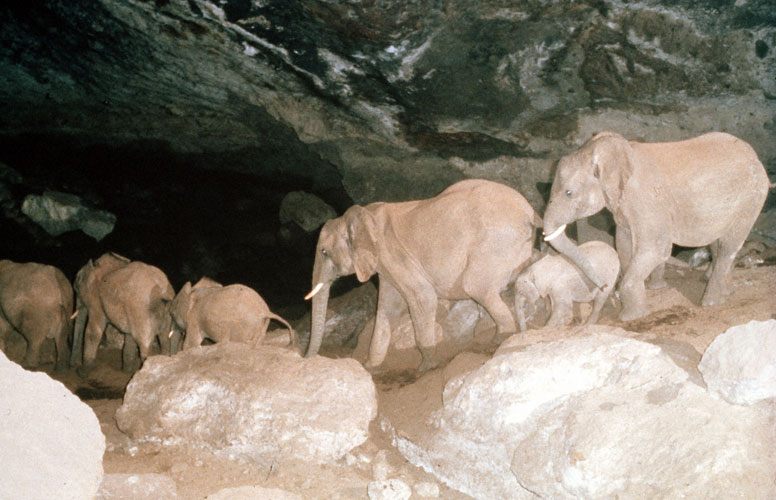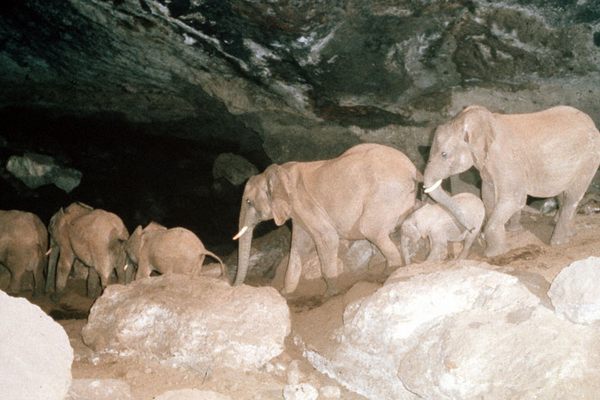From Elephant Tongues to Faulty Air Conditioners: The Geographical Origins of Deadly Diseases
As the international medical community works to deal with the current Ebola outbreak, a lot of work is being done to isolate the disease vector, the animals that carry and spread the disease. Most theories currently point to bats as the carriers, although there is more work to be done before this is accepted as truth. This conclusion would not be surprising, however, as bats are known vectors for many other diseases. After years of diligent study, scientists have often been able to pinpoint not just the species that spreads the disease, but also the specific location where it began. Here are four such instances.
Marburg Virus: The Kitum Cave
 Herd of elephants inside Kitum Cave, photo via Dr. Ian Redmond
Herd of elephants inside Kitum Cave, photo via Dr. Ian Redmond
In the 1980s, a new strain of Marburg — a hemorrhagic fever virus similar to Ebola — proved fatal to a Frenchman and a Danish teenager, both of whom had visited Kenya’s Kitum Cave. Kitum is one of five “elephant caves” in Mount Elgon National Park, so-called because it has been dug out by a variety of animals seeking the salt in the cave’s walls. Elephants in particular use their massive tusks to break off chunks of the wall, which they masticate to extract the salt. The cave is also home to a large population of fruit bats, which were proven, after decades of study, to be the Marburg vector: the virus was propagated by inhalation of powdered guano.
Lloviu Virus: The Lloviu Cave

Schreiber’s long-fingered bat, image by C. Robiller/naturlichter.de via Wikimedia
Though it has not yet been shown to be pathogenic for humans, the Lloviu Virus, a filovirus like Ebola, has proven deadly to the bats that carry it. It was first discovered in 2002 in the Spanish cave Cuevo del Lloviu, and was also traced to substantial bat die-offs in other caves in France and Portugal. This was the first time a filovirus was found outside of Sub-Saharan Africa or the Phillipines, suggesting that filoviruses may be mutating.
Hantavirus Pulmonary Syndrome: Four Corners
 View to Canyon del Muerto from Junction Overlook, photo by Nikater via Wikimedia
View to Canyon del Muerto from Junction Overlook, photo by Nikater via Wikimedia
Bats are by no means the only small animal that can act as a disease vector. In the case of the hantavirus, there are many, many different strains, each transmitted to humans via contact with the urine or feces of a different species of mouse. The Bayou virus is linked to the rice rat, the Black Creek Canal virus to the cotton rat, the New York-1 virus to the white-footed mouse, and Hantavirus Pulmonary Syndrome (originally called the Muerto Canyon virus) to deer mice. In 1993, the Four Corners outbreak marked the first instance of a hantavirus outbreak in the United States. The cause was the fact that there was significant rain-and snowfall that year, after several years of drought, leading to a revival of plant life and a large jump in deer mice, a rodent that lives in close proximity to people.
Legionnaires Disease: The Bellevue-Stratford Hotel
 Philadelphia’s Bellevue-Stratford Hotel, photo by Jack E. Boucher via Wikimedia
Philadelphia’s Bellevue-Stratford Hotel, photo by Jack E. Boucher via Wikimedia
Sometimes it’s much easier to trace the source of a disease than spending years testing various animal. Legionnaire’s Disease, an illness similar to pneumonia, is not airborne or communicable person-to-person, instead it travels through aquatic systems, such as whirlpool spas, air humidifiers, grocery store misting systems, and ornamental fountains. The first recorded incident of the disease occurred in 1976 at convention at the Philadelphia Bellevue-Stratford Hotel of the American Legion — hence the name of the virus, Legionella. During that outbreak, 221 cases were recorded, of which 34 were fatal. The disease was ultimately traced to the air-conditioning cooling tower on the nearby Stafford District Hospital roof.








Follow us on Twitter to get the latest on the world's hidden wonders.
Like us on Facebook to get the latest on the world's hidden wonders.
Follow us on Twitter Like us on Facebook